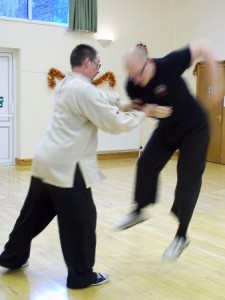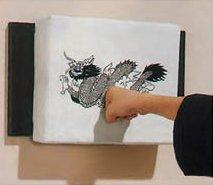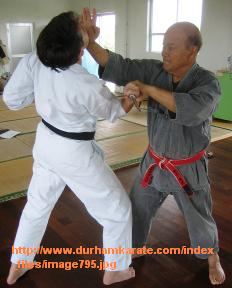How often have you heard the phrase “before you can overcome others, you must first overcome yourself”, or “your main opponent is yourself”. If you’ve never heard these phrases, then take a long look at who’s teaching you! You should have heard these phrases before as this really is one of the most central core philosophies of doing any traditional martial art.
Whether you are looking for effective self defence, sport or simply aesthetic mastery of the art you practice you must first develop co-ordination, agility, speed, power, poise, balance and grace. From a combative point of view, the need for speed, power, co-ordination and balance are obvious; but grace? Do we need to be graceful in a fight? Many consider the very act of fighting to be very disgraceful.
However, if you execute a technique and for whatever reason the opponent deals with it and counters, you have to react exceedingly fast to defend against his counter. This kind of speed requires an instinctive reaction rather than a thought or reasoned one. If we are focusing on strength, we become rigid (the more you tense a muscle the less it can move). If we are rigid, then we cannot react very fast to an abrupt reversal in the fight and we have to hope we can absorb the punishment long enough for us to recover the initiative.
Whilst we would all no doubt agree that the ability to absorb punishment is useful, I’m sure that we would also all agree that it is not something that we should rely on as a fighting strategy. If we can move out of the way with ease and fluidity, we don’t have to absorb so much punishment and can regain the initiative much more quickly by simply not being where our opponent expects us to be. To move very quickly like this requires a high level of fluidity, and fluidity requires graceful movement! Don’t be fooled into thinking that grace lacks power, as it is quite the opposite. Grace comes from perfection of technique and perfection of technique comes from mastering the self. This brings us back to our opening paragraph about overcoming yourself before you can overcome anybody else.
This is why so many traditional martial arts place so much emphasis on drilling basics and kata, and why these are very often done before any partner activity. In the modern world where there is an upsurge in what has become known as “reality based martial arts” and the pressure testing of mixed martial arts cage fighting; traditional martial arts have become seen by many as obsolete, too stylised and more for sport or self development than for real world self protection.
Note: Reality based martial arts are often scenario based. It may include shouting, swearing, abuse and verbal threats to psychologically prepare the defender as this is obviously more real to a street confrontation. Sometimes even high grade martial artists do not know how to deal with this raw aggression and psychological pressure.
It is often pointed out that many traditional martial arts applications only work when the attacker is co-operative and conveniently attacks with a single straight punch (or kick) then freezes whilst the defender practices his counter.
These charges do hold a lot of merit. However, reality based martial arts can easily be included into traditional martial arts (and in my view, should be) and there are many people researching practical applications to replace the pre-arranged stylised attacks and counters that are still very widely taught.
Traditional martial arts however, are more technique based than scenario based and goes deeply into perfection of movement. Is this waste of time compared with learning the psychological aspects of scenario based training?
To draw an analogy, many professional dancers in the big shows, backing the world’s most famous pop stars have a foundation in ballet. Ballet is such a precise and co-ordinated art form that once the dancer is adept in it, he/she can apply that high level of control and co-ordination to almost any other form of dance.
Some of the most charismatic actors have a background in Shakespeare. Look at the authority and commanding screen presence of actors like Patrick Stewart and Ian McKellen. The classical background in most cases (dancing, acting, martial arts and others) gives the practitioner a deep foundation on which almost anything can be built.
Kevin O’Hagan, internationally renowned teacher of reality based martial arts and author of many books has said that traditional martial artists always pick up the reality based teachings more quickly than those who have not.
Seeking perfection of technique is not only developing us physically and mentally, but is actually very practical in the long term for building a foundation for self defence skills. Over the years I have visited many martial arts clubs. In one particular Kung Fu club, the instructor was proud to tell me that he made all his classes different every time. He did not bore his students with endless repetition. One of students agreed enthusiastically, telling me how he used to do Shotokan Karate and got bored drilling the same old basics every single class. However, this student who had done the Shotokan drilling stuck out amongst the rest and was clearly better than the other students. The repeated drilling had given him a foundation and an advantage that he had not appreciated.
I want to make clear that this is not a criticism of Kung Fu, only the way that this particular instructor taught it.
Striving for perfection, even though we know that we’ll never actually reach it, does in itself also develop a certain mindset. A mindset of wanting to make something the best it possibly can be. This has many connotations for other areas of our lives, be it school, work, relationships, driving, other hobbies, whatever!
The Japanese have the concept of delayed gratification. This is also known in the West, but is not emphasised as much. The idea is that we work at something over a period of time and delay our feeling of gratification until we have achieved it. Like a grading for example. Even going through the Kyu gradings (coloured belts) we have to wait 3 months in between each one. But when we do pass it, we have a feeling of gratification which lasts. When we get our 1st Dan the feeling of gratification is much stronger and lasts much longer. We still have a feeling of pride years afterwards as we know that we have achieved a benchmark in our training. For many of us, it even becomes part of how we identify ourselves, which along as it is not accompanied by arrogance is a good thing.
 Too many people, especially in the West are very much into instant gratification, be it drink, drugs, sex, smoking, or just watching a good movie. I’m not saying that these things are necessarily bad (being a normal healthy guy myself who . . . . err . . . . likes a good movie); but if they are our only sources of gratification in life, then they will be short lived as there is not much to sustain us and maintain a feeling of fulfilment from one source/event of gratification to the next. We are therefore not really at peace with ourselves.
Too many people, especially in the West are very much into instant gratification, be it drink, drugs, sex, smoking, or just watching a good movie. I’m not saying that these things are necessarily bad (being a normal healthy guy myself who . . . . err . . . . likes a good movie); but if they are our only sources of gratification in life, then they will be short lived as there is not much to sustain us and maintain a feeling of fulfilment from one source/event of gratification to the next. We are therefore not really at peace with ourselves.
Having a long term goal, a long term project or training regime does give us that something to sustain us and help us maintain a feeling of fulfilment in between the other more instant sources of gratification.
There are countless things that people can work on, train for, set goals about; but few can inspire for a lifetime like martial arts. In most sports or physical pursuits people reach a peak then tend to move on as they age. Martial arts (when taught properly) can be adapted as we age and we can work on other aspects. In our youth it is good to make the most of our raw athleticism of, but as we get older we may focus on for example our timing and deception. No matter how much we know, how much we’ve trained, how much we’ve taught; there is still something else we can work on and improve however old we get.
The fact that we will never reach perfection means that we can spend our whole lifetime looking for it and rather than feeling bored we feel fulfilled the closer we get to it. This is part of where spiritual development comes into martial arts, something often referred to but seldom explained.



 Karate Depot have asked me to review a makiwara (striking board) for them. But first, I would like to talk about what makawara training is actually trying to achieve as it not quite what most people imagine.
Karate Depot have asked me to review a makiwara (striking board) for them. But first, I would like to talk about what makawara training is actually trying to achieve as it not quite what most people imagine.
